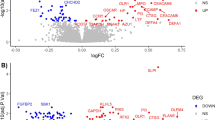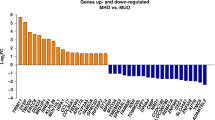Abstract
Background:
There is emerging evidence suggesting the role of peripheral blood leukocytes in the pathogenesis of obesity and related diseases. However, few studies have taken a genome-wide approach to investigating gene expression profiles in peripheral leukocytes between obese and lean individuals with the consideration of obesity-related shifts in leukocyte types.
Method:
We conducted this study in 95 African Americans (AAs) of both genders (age 14–20 years, 46 lean and 49 obese). Complete blood count with differential test (CBC) was performed in whole blood. Genome-wide gene expression analysis was obtained using the Illumina HumanHT-12 V4 Beadchip with RNA extracted from peripheral leukocytes. Out of the 95 participants, 64 had neutrophils stored. The validation study was based on real-time PCR with RNA extracted from purified neutrophils.
Results:
CBC test suggested that, in males, obesity was associated with increased neutrophil percentage (P=0.03). Genome-wide gene expression analysis showed that, in males, the majority of the most differentially expressed genes were related to neutrophil activation. Validation of the gene expression levels of ELANE (neutrophil elastase) and MPO (myeloperoxidase) in purified neutrophils demonstrated that the expression of these two genes—important biomarkers of neutrophils activation—were significantly elevated in obese males (P=0.01 and P=0.02, respectively).
Conclusion:
The identification of increased neutrophil percentage and activation in obese AA males suggests that neutrophils have an essential role in the pathogenesis of obesity-related disease. Further functional and mechanistic studies on neutrophils may contribute to the development of novel intervention strategies reducing the burden associated with obesity-related health problems.
This is a preview of subscription content, access via your institution
Access options
Subscribe to this journal
Receive 12 print issues and online access
$259.00 per year
only $21.58 per issue
Buy this article
- Purchase on Springer Link
- Instant access to full article PDF
Prices may be subject to local taxes which are calculated during checkout


Similar content being viewed by others
References
Kearney PM, Whelton M, Reynolds K, Muntner P, Whelton PK, He J . Global burden of hypertension: analysis of worldwide data. Lancet 2005; 365: 217–223.
Poirier P, Giles TD, Bray GA, Hong Y, Stern JS, Pi-Sunyer FX et al. Obesity and cardiovascular disease: pathophysiology, evaluation, and effect of weight loss: an update of the 1997 American Heart Association Scientific Statement on Obesity and Heart Disease from the Obesity Committee of the Council on Nutrition, Physical Activity, and Metabolism. Circulation 2006; 113: 898–918.
O'Rourke RW . Inflammation in obesity-related diseases. Surgery 2009; 145: 255–259.
Bullo M, Garcia-Lorda P, Megias I, Salas-Salvado J . Systemic inflammation, adipose tissue tumor necrosis factor, and leptin expression. Obes Res 2003; 11: 525–531.
Festa A, D'Agostino R Jr ., Williams K, Karter AJ, Mayer-Davis EJ, Tracy RP et al. The relation of body fat mass and distribution to markers of chronic inflammation. Int J Obes Relat Metab Disord 2001; 25: 1407–1415.
Ghosh S, Dent R, Harper ME, Gorman SA, Stuart JS, McPherson R . Gene expression profiling in whole blood identifies distinct biological pathways associated with obesity. BMC Med Genomics 2010; 3: 56.
Hindle AK, Koury J, McCaffrey T, Fu SW, Brody F . Dysregulation of gene expression within the peroxisome proliferator activated receptor pathway in morbidly obese patients. Surg Endosc 2009; 23: 1292–1297.
Xu X, Su S, Barnes VA, De Miguel C, Pollock J, Ownby D et al. A genome-wide methylation study on obesity: Differential variability and differential methylation. Epigenetics 2013; 8: 522–533.
Body Mass Index: BMI for Children and Teens. Center for Disease Control. CDC: Atlanta, GA, USA, 2013.
De AK, Roach SE, De M, Minielly RC, Laudanski K, Miller-Graziano CL et al. Development of a simple method for rapid isolation of polymorphonuclear leukocytes from human blood. J Immunoassay Immunochem 2005; 26: 35–42.
Smthy GK . Bioinformatics and Computational Biology Solutions Using R and Bioconductor. Springer New York, NY, USA, 2005.
Benjamini Y, Hochberg Y . Controlling the false discovery rate: a practical and powerful approach to multiple testing. J R Stat Soc Ser B 1995; 57: 289–300.
Fisch IR, Freedman SH . Smoking, oral contraceptives, and obesity. Effects on white blood cell count. JAMA 1975; 234: 500–506.
Dixon JB, O'Brien PE . Obesity and the white blood cell count: changes with sustained weight loss. Obes Surg 2006; 16: 251–257.
Kintscher U, Hartge M, Hess K, Foryst-Ludwig A, Clemenz M, Wabitsch M et al. T-lymphocyte infiltration in visceral adipose tissue: a primary event in adipose tissue inflammation and the development of obesity-mediated insulin resistance. Arterioscler Thromb Vasc Biol 2008; 28: 1304–1310.
Subramanian V, Ferrante AW Jr . Obesity, inflammation, and macrophages. Nestle Nutr Workshop Ser Paediatr Program 2009; 63: 151–159. discussion 159–62, 259–68.
Ilavska S, Horvathova M, Szabova M, Nemessanyi T, Jahnova E, Tulinska J et al. Association between the human immune response and body mass index. Hum Immunol 2012; 73: 480–485.
Viardot A, Heilbronn LK, Samocha-Bonet D, Mackay F, Campbell LV, Samaras K . Obesity is associated with activated and insulin resistant immune cells. Diabetes Metab Res Rev 2012; 28: 447–454.
Al-Sufyani AA, Mahassni SH . Obesity and immune cells in Saudi females. Innate Immun 2011; 17: 439–450.
Herishanu Y, Rogowski O, Polliack A, Marilus R . Leukocytosis in obese individuals: possible link in patients with unexplained persistent neutrophilia. Eur J Haematol 2006; 76: 516–520.
Mansuy-Aubert V, Zhou QL, Xie X, Gong Z, Huang JY, Khan AR et al. Imbalance between neutrophil elastase and its inhibitor alpha1-antitrypsin in obesity alters insulin sensitivity, inflammation, and energy expenditure. Cell Metab 2013; 17: 534–548.
Talukdar S, Oh da Y, Bandyopadhyay G, Li D, Xu J, McNelis J et al. Neutrophils mediate insulin resistance in mice fed a high-fat diet through secreted elastase. Nat Med 2012; 18: 1407–1412.
Hadad N, Burgazliev O, Elgazar-Carmon V, Solomonov Y, Wueest S, Item F et al. Induction of cytosolic phospholipase a2alpha is required for adipose neutrophil infiltration and hepatic insulin resistance early in the course of high-fat feeding. Diabetes 2013; 62: 3053–3063.
Paczek L, Michalska W, Bartlomiejczyk I . Trypsin, elastase, plasmin and MMP-9 activity in the serum during the human ageing process. Age Ageing 2008; 37: 318–323.
Bonithon-Kopp C, Touboul PJ, Berr C, Magne C, Ducimetiere P . Factors of carotid arterial enlargement in a population aged 59 to 71 years: the EVA study. Stroke 1996; 27: 654–660.
Bizbiz L, Bonithon-Kopp C, Ducimetiere P, Berr C, Alperovitch A, Robert L . Relation of serum elastase activity to ultrasonographically assessed carotid artery wall lesions and cardiovascular risk factors. The EVA study. Atherosclerosis 1996; 120: 47–55.
Piwowar A, Knapik-Kordecka M, Warwas M . Concentration of leukocyte elastase in plasma and polymorphonuclear neutrophil extracts in type 2 diabetes. Clin Chem Lab Med 2000; 38: 1257–1261.
Olza J, Aguilera CM, Gil-Campos M, Leis R, Bueno G, Martinez-Jimenez MD et al. Myeloperoxidase is an early biomarker of inflammation and cardiovascular risk in prepubertal obese children. Diabetes Care 2012; 35: 2373–2376.
Flo TH, Smith KD, Sato S, Rodriguez DJ, Holmes MA, Strong RK et al. Lipocalin 2 mediates an innate immune response to bacterial infection by sequestrating iron. Nature 2004; 432: 917–921.
Kuroki M, Abe H, Imakiirei T, Liao S, Uchida H, Yamauchi Y et al. Identification and comparison of residues critical for cell-adhesion activities of two neutrophil CD66 antigens, CEACAM6 and CEACAM8. J Leukoc Biol 2001; 70: 543–550.
Clemmensen SN, Bohr CT, Rorvig S, Glenthoj A, Mora-Jensen H, Cramer EP et al. Olfactomedin 4 defines a subset of human neutrophils. J Leukoc Biol 2012; 91: 495–500.
Watorek W . Azurocidin – inactive serine proteinase homolog acting as a multifunctional inflammatory mediator. Acta biochim Pol 2003; 50: 743–752.
Berisha SZ, Serre D, Schauer P, Kashyap SR, Smith JD . Changes in whole blood gene expression in obese subjects with type 2 diabetes following bariatric surgery: a pilot study. PLoS One 2011; 6: e16729.
O'Shea D, Cawood TJ, O'Farrelly C, Lynch L . Natural killer cells in obesity: impaired function and increased susceptibility to the effects of cigarette smoke. PLoS One 2010; 5: e8660.
Lynch LA, O'Connell JM, Kwasnik AK, Cawood TJ, O'Farrelly C, O'Shea DB . Are natural killer cells protecting the metabolically healthy obese patient? Obesity (Silver Spring) 2009; 17: 601–605.
Acknowledgements
This study was supported by a grant HL105689 from the National Institute of Health. We would like to extend a special thanks to all the participants for their involvment in our study. We are especially grateful to the staffs in our departments for their help in recruitment, data collection and lab experiments.
Author information
Authors and Affiliations
Corresponding author
Ethics declarations
Competing interests
The authors declare no conflict of interest.
Additional information
Supplementary Information accompanies this paper on International Journal of Obesity website
Supplementary information
Rights and permissions
About this article
Cite this article
Xu, X., Su, S., Wang, X. et al. Obesity is associated with more activated neutrophils in African American male youth. Int J Obes 39, 26–32 (2015). https://doi.org/10.1038/ijo.2014.194
Received:
Revised:
Accepted:
Published:
Issue Date:
DOI: https://doi.org/10.1038/ijo.2014.194
This article is cited by
-
Patients with schizophrenia and bipolar disorder display a similar global gene expression signature in whole blood that reflects elevated proportion of immature neutrophil cells with association to lipid changes
Translational Psychiatry (2023)
-
Proteomic analysis identifies a signature of disease severity in the plasma of COVID-19 pneumonia patients associated to neutrophil, platelet and complement activation
Clinical Proteomics (2022)
-
Effects of obesity on NK cells in a mouse model of postmenopausal breast cancer
Scientific Reports (2020)
-
Combating osteoporosis and obesity with exercise: leveraging cell mechanosensitivity
Nature Reviews Endocrinology (2019)
-
Discovery and Validation of a Novel Neutrophil Activation Marker Associated with Obesity
Scientific Reports (2019)



